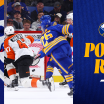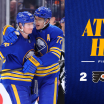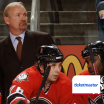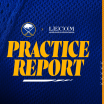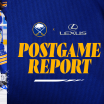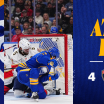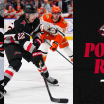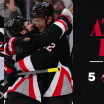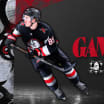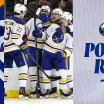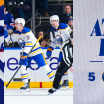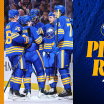VANCOUVER -We're now one full week into the NHL season, and only three teams currently sit among the top 10 in the League on both the power play and the penalty kill: the Carolina Hurricanes, the Tampa Bay Lightning and, naturally with this being Sabres.com, the Sabres.
Through three games, Buffalo is a perfect 9-for-9 on the penalty kill (one of three perfect teams remaining along with Florida and Minnesota), while their 25-percent conversion rate on the power-play (4-for-16) ranks eighth in the League.
Three games in, Sabres are excelling on special teams
Buffalo is one of three teams to rank in top 10 on both the penalty kill and the power play.
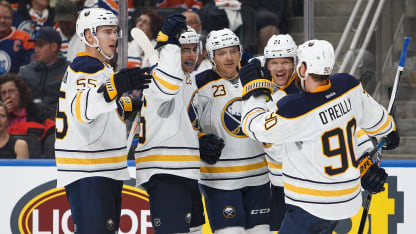
© Codie McLachlan/Getty Images
So far, both units have been anchored by the same two names: Rasmus Ristolainen and Ryan O'Reilly. Ristolainen ranks atop the team with an average shorthanded ice time of 3:08; O'Reilly is second at 2:01. Ristolainen ranks fourth in the League in average power-play ice time at 5:35 per game; O'Reilly ranks eighth at 5:18.
The irony in Buffalo's power-play success is that the goals they've scored have come from a group of players who had almost no time to work together in the preseason. Ristolainen missed the majority of training camp while negotiating a new contract. By the time he returned to practice, O'Reilly and Kyle Okposo were absent due to injury.
The unfamiliarity hasn't stopped them. All four of Buffalo's goals with the extra man have come from its top unit, comprised of Ristolainen, O'Reilly, Okposo, Sam Reinhart and Matt Moulson. Okposo even missed the team's first game due to injury, but fed O'Reilly for a goal on his very first power play with the team on Sunday in Edmonton. O'Reilly scored another on Tuesday in Calgary, while Moulson has accounted for the other two goals.
So, what makes them click? Moulson said it starts with O'Reilly, Ristolainen and Okposo, who move the puck around at the top of the zone until they find the open man to take a shot. Moulson and Reinhart are the men down low who attempt to score on screens, tips or rebounds.
"They're scored their four goals a couple different ways," Sabres coach Dan Bylsma said. "I think one of the keys on our power play is being a shooting power play and a recovering power play and the goal we had last night was a direct result of that."
That goal was simply Ristolainen drawing a defender with the puck before passing it off to O'Reilly, who put the puck on the net and got a fortunate bounce off a defender. Other times, the puck could find its way in as a result of Reinhart screening in front of the net or Moulson cleaning up rebounds in the slot.
The goal from Okposo to O'Reilly on Sunday was another example of the benefits of a shooting mentality. They cycled the puck until all five members were on their strong sides, and Okposo got the puck above the right wing circle on three occasions. The first two times, he shot into traffic to no avail. He changed it up the third time around, faking a shot and instead sneaking a hard pass through the defense to O'Reilly down low.
The common denominator on all four of Buffalo's power-play goals has been Ristolainen, who has earned either a primary or secondary assist on each. That, according to Moulson, is a testament to the young defenseman's advanced decision making.
"He's a great, great player. He's smart out there," Moulson said. "You're trying to create an advantage on the ice when you have an extra guy out there. He does a great job of quarterbacking, getting the puck up the ice. He makes great decisions."
The team's success on the penalty kill, meanwhile, actually began last season, when they finished at ninth in the League with an 82.6 percent success rate. Josh Gorges is a regular on the penalty kill, and he said it all goes back to the team choosing to do two things: taking pride in fundamentals, which begins in defending hard against the power play in practice, and accepting that the penalty kill doesn't work unless all four skaters and the goalie are aware of what the rest are doing.
Sabres goalie Robin Lehner is as vocal as they come, and he's come up big on the penalty kill so far.
"Your goalie always has to be your best penalty killer," Gorges said. "They got an extra guy on the ice, they're gonna make plays. They're gonna create themselves opportunities. If we can limit those opportunities [so the goalies] know where those opportunities are gonna come from where he doesn't have to second guess and try to make a quick decision, he can get set before and I think it makes his job easier. But even when he has to, he's been there to bail us out."
Toronto coach Mike Babcock, who coached O'Reilly at the World Cup of Hockey, said it was O'Reilly's penalty killing skills that earned him a late roster spot on Team Canada. Naturally, the Sabres rely heavily on O'Reilly when shorthanded. O'Reilly was the only player in the NHL last season to average 2-plus minutes on the penalty kill while also averaging 3-plus minutes on the power play.
Gorges said that O'Reilly's value on the penalty kill begins in the faceoff circle. O'Reilly has been one of two primary faceoff men for the Sabres while shorthanded (along with Derek Grant) and is 4-for-5 in those situations. His 126 shorthanded faceoff wins last season ranked sixth in the League despite missing 11 games due to injury.
"The other side of it is he's just such a smart hoc key player," Gorges said. "When things break down, he knows where to be. He knows the position. He knows how to force the other team into tough situation and he's got a great stick on top of it."
That great stick came into play on Tuesday with the Sabres midway through killing a 5-on-3 power play for the Flames. O'Reilly came in from behind and stole the puck from Mark Giordano, which ended up leading to a high-sticking call against Giordano to cut the two-man disadvantage in half.
The Sabres will have an opportunity to extend their penalty kill streak to four games on Thursday; their opponent, the Vancouver Canucks, is one of three teams remaining who have yet to score a power-play goal. With that being said, the Canucks are also undefeated and rank third in the League with 1.67 goals-against per game.
It's an important game for the Sabres, who have a chance to come away from their three-game road trip in Western Canada with five points. If they can keep the ball rolling on special teams, it might just make the difference.
Wednesday's practice
Johan Larsson was absent from practice for a maintenance day, but Bylsma said he should be ready to play against the Canucks on Thursday. Here's how the lines looked in his absence:
23 Sam Reinhart - 90 Ryan O'Reilly - 21 Kyle Okposo
63 Tyler Ennis - 27 Derek Grant - 12 Brian Gionta
82 Marcus Foligno - 28 Zemgus Girgensons - 44 Nicolas Deslauriers
26 Matt Moulson - 73 Nick Baptiste - 52 Hudson Fasching
4 Josh Gorges - 55 Rasmus Ristolainen
29 Jake McCabe - 47 Zach Bogosian
77 Dmitry Kulikov - 6 Cody Franson
34 Casey Nelson
40 Robin Lehner
31 Anders Nilsson

